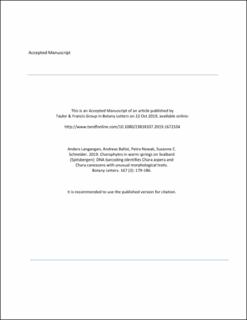| dc.contributor.author | Langangen, Anders | |
| dc.contributor.author | Ballot, Andreas | |
| dc.contributor.author | Nowak, Petra | |
| dc.contributor.author | Schneider, Susanne C | |
| dc.date.accessioned | 2020-09-17T09:02:40Z | |
| dc.date.available | 2020-09-17T09:02:40Z | |
| dc.date.created | 2020-01-14T13:31:10Z | |
| dc.date.issued | 2019 | |
| dc.identifier.citation | Botany Letters. 2019, 167 (2), 179-186. | en_US |
| dc.identifier.issn | 2381-8107 | |
| dc.identifier.uri | https://hdl.handle.net/11250/2678191 | |
| dc.description.abstract | The Troll springs are warm springs on Svalbard (Spitsbergen). Charophytes were collected in the years 1910, 1912, 1958, 1992/1993, and 2018. However, since the Chara samples showed unusual morphological traits, there were doubts with respect to species identity. We here use DNA barcoding to show that there occur two Chara species in the Troll springs: Chara aspera and C. canescens. | en_US |
| dc.language.iso | eng | en_US |
| dc.publisher | Taylor & Francis | en_US |
| dc.title | Charophytes in warm springs on Svalbard (Spitsbergen): DNA barcoding identifies Chara aspera and Chara canescens with unusual morphological traits | en_US |
| dc.type | Peer reviewed | en_US |
| dc.type | Journal article | en_US |
| dc.description.version | acceptedVersion | en_US |
| dc.source.pagenumber | 179-186 | en_US |
| dc.source.volume | 167 | en_US |
| dc.source.journal | Botany Letters | en_US |
| dc.source.issue | 2 | en_US |
| dc.identifier.doi | 10.1080/23818107.2019.1672104 | |
| dc.identifier.cristin | 1772401 | |
| dc.relation.project | Svalbards miljøvernfond: 17/68 | en_US |
| cristin.ispublished | true | |
| cristin.fulltext | postprint | |
| cristin.qualitycode | 1 | |
